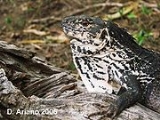
Guatemalan Spiny-tailed Iguana
Encyclopedia
The Guatemalan spiny-tailed iguana (Ctenosaura palearis) is a species of spiny-tailed iguana
endemic to the Motagua Valley, Guatemala
. This species is threatened by habitat loss and illegal trade. These iguanas are used as a source of food by natives. Its eggs
are a food source for the equally threatened Motagua Valley beaded lizard
(Heloderma horridum charlesbogerti), thereby possibly linking the status of the two species. It is included in CITES appendix II so that trade on this species is regulated.
The Guatemalan spiny-tailed iguana feeds on leaves and the fruits of the cactus Stenocereus
pruinosus and occasionally insects (cricket
s, beetle
s, ant
s and wasp). The habitat of C. palearis is characterized by a greater frequency of S. pruinosus, Albizzia idiopoda, Ximena americana and Acacia
deamii. The Guatemalan spiny-tailed iguana can be regarded as a keystone species
because it plays an important role in seed dispersal
of S. pruinosus.
Ctenosaura
Ctenosaura is a genus of lizard commonly known as spinytail iguanas. The genus is part of the large lizard family, Iguanidae and is native to Mexico and Central America. The species range in size from about 5 inches to well over one meter. The distinctive feature of this genus is presence of the...
endemic to the Motagua Valley, Guatemala
Guatemala
Guatemala is a country in Central America bordered by Mexico to the north and west, the Pacific Ocean to the southwest, Belize to the northeast, the Caribbean to the east, and Honduras and El Salvador to the southeast...
. This species is threatened by habitat loss and illegal trade. These iguanas are used as a source of food by natives. Its eggs
Egg (biology)
An egg is an organic vessel in which an embryo first begins to develop. In most birds, reptiles, insects, molluscs, fish, and monotremes, an egg is the zygote, resulting from fertilization of the ovum, which is expelled from the body and permitted to develop outside the body until the developing...
are a food source for the equally threatened Motagua Valley beaded lizard
Heloderma horridum charlesbogerti
The Motagua Valley beaded lizard, Heloderma horridum charlesbogerti, is a highly endangered subspecies of beaded lizard, a venomous lizard endemic to the dry forests of the Motagua Valley in southeastern Guatemala. It is the only allopatric subspecies, separated from the nearest population of...
(Heloderma horridum charlesbogerti), thereby possibly linking the status of the two species. It is included in CITES appendix II so that trade on this species is regulated.
The Guatemalan spiny-tailed iguana feeds on leaves and the fruits of the cactus Stenocereus
Stenocereus
Stenocereus is a genus of columnar or tree-like cacti from the Baja California Peninsula and other parts of Mexico, Arizona in the United States, Costa Rica, Guatemala, Venezuela and the ABC islands of the Dutch Caribbean. The genus has been enlarged by the addition of species from several other...
pruinosus and occasionally insects (cricket
Cricket
Cricket is a bat-and-ball game played between two teams of 11 players on an oval-shaped field, at the centre of which is a rectangular 22-yard long pitch. One team bats, trying to score as many runs as possible while the other team bowls and fields, trying to dismiss the batsmen and thus limit the...
s, beetle
Beetle
Coleoptera is an order of insects commonly called beetles. The word "coleoptera" is from the Greek , koleos, "sheath"; and , pteron, "wing", thus "sheathed wing". Coleoptera contains more species than any other order, constituting almost 25% of all known life-forms...
s, ant
Ant
Ants are social insects of the family Formicidae and, along with the related wasps and bees, belong to the order Hymenoptera. Ants evolved from wasp-like ancestors in the mid-Cretaceous period between 110 and 130 million years ago and diversified after the rise of flowering plants. More than...
s and wasp). The habitat of C. palearis is characterized by a greater frequency of S. pruinosus, Albizzia idiopoda, Ximena americana and Acacia
Acacia
Acacia is a genus of shrubs and trees belonging to the subfamily Mimosoideae of the family Fabaceae, first described in Africa by the Swedish botanist Carl Linnaeus in 1773. Many non-Australian species tend to be thorny, whereas the majority of Australian acacias are not...
deamii. The Guatemalan spiny-tailed iguana can be regarded as a keystone species
Keystone species
A keystone species is a species that has a disproportionately large effect on its environment relative to its abundance. Such species play a critical role in maintaining the structure of an ecological community, affecting many other organisms in an ecosystem and helping to determine the types and...
because it plays an important role in seed dispersal
Seed dispersal
Seed dispersal is the movement or transport of seeds away from the parent plant. Plants have limited mobility and consequently rely upon a variety of dispersal vectors to transport their propagules, including both abiotic and biotic vectors. Seeds can be dispersed away from the parent plant...
of S. pruinosus.

